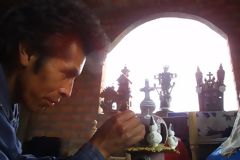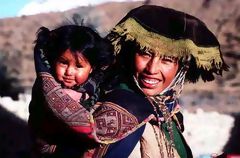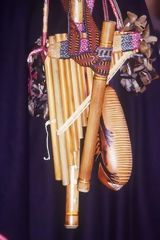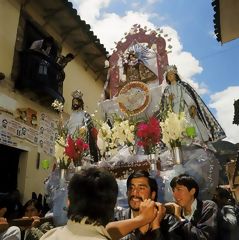 The art before the Spanish colonization was based almost entirely on the production
of potteries, metal and stone working, and also textiles. Spanish introduced
the urban planning, with cities organized in a chessboard style, and built houses,
churches and monasteries imitating the Spanish renaissance, or maybe the phlegmatic
neo-baroque Spanish style. Years later, this European styles shown more and
more signs of native Indian influences, as the result we have a style known
as a "mestizo" (half-caste) (the best examples of mestizo
architecture are around Puno and Arequipa).
The painting also imitated the European influence, but as long as local artists
were asserted, a new and different "Cuzco" was developed, in
which artists took distance from the real world to focus on tales and fables.
The influence of these works on Gauguin (whose mother was Peruvian, and
who spent his childhood in Lima)
is remarkable.
The art before the Spanish colonization was based almost entirely on the production
of potteries, metal and stone working, and also textiles. Spanish introduced
the urban planning, with cities organized in a chessboard style, and built houses,
churches and monasteries imitating the Spanish renaissance, or maybe the phlegmatic
neo-baroque Spanish style. Years later, this European styles shown more and
more signs of native Indian influences, as the result we have a style known
as a "mestizo" (half-caste) (the best examples of mestizo
architecture are around Puno and Arequipa).
The painting also imitated the European influence, but as long as local artists
were asserted, a new and different "Cuzco" was developed, in
which artists took distance from the real world to focus on tales and fables.
The influence of these works on Gauguin (whose mother was Peruvian, and
who spent his childhood in Lima)
is remarkable.
Peruvian literature includes everything from the controversy inspired on the independence to anarchist individualism of its poets, passing through the childish dreams of the internationally known Mario Vargas Llosa.
 There
are almost 70 different dialects in Peru,
and besides the distant places of the Amazon,
Spanish is spoken. In the higher areas, Quechua (which is also an official
language) is generally spoken. English is often understood (also in many hotels),
but it is not much used. The Aymara is another of the current spoken
dialects. See also the Spanish vocabulary.
There
are almost 70 different dialects in Peru,
and besides the distant places of the Amazon,
Spanish is spoken. In the higher areas, Quechua (which is also an official
language) is generally spoken. English is often understood (also in many hotels),
but it is not much used. The Aymara is another of the current spoken
dialects. See also the Spanish vocabulary.
 Only
a few South American countries can be proud of such a variety of music.
Who doesn't know the characteristic Andean music, of pre-Colombian influence,
played with traditional instruments as the quena, siku (pan flute)
and drums. It's not the only one, several folk music use, besides those instruments,
the guitar, the violin, the harp, the charango (small guitar whose case
is made of armadillo shell). The Indian fanfares, where brasses and bass drums
have an important place, and accompany the village's dances and carnivals.
Only
a few South American countries can be proud of such a variety of music.
Who doesn't know the characteristic Andean music, of pre-Colombian influence,
played with traditional instruments as the quena, siku (pan flute)
and drums. It's not the only one, several folk music use, besides those instruments,
the guitar, the violin, the harp, the charango (small guitar whose case
is made of armadillo shell). The Indian fanfares, where brasses and bass drums
have an important place, and accompany the village's dances and carnivals.
All this wealth and variety is shown in many dances: the marinera, the festejo, the lando, the negritos, the salsa from African influence; the huayno, huaylash, yaravi muliza are a result of the Spanish-Indian interbreeding; not mentioning the Creole kinds as waltz and polkas. Others are purely native like the huifala, the llamerada, the ayarachis, and the chiriguanas, to mention some of them.
 Many
important holidays in Peru come form the Catholic Roman Church liturgy
calendar. They are often celebrated in a pagan way, mostly in Indian villages
in the high-plateau, where the catholic holiday is often associated to a traditional
agricultural celebration. The most important holidays are: The Carnival (February-March),
very popular in Peru and symbolized by water battles; the Inti Raymi
(June 24th), the most important one with spectacular dances and parades; the
Independence Day (July 28th); the All Saint's Day (November 1st),
celebrated with offertories of food, beverages and flowers put on family crypts;
and Day of Puno (November 5th), with flaming costumes and dances in the
streets of Puno.
Many
important holidays in Peru come form the Catholic Roman Church liturgy
calendar. They are often celebrated in a pagan way, mostly in Indian villages
in the high-plateau, where the catholic holiday is often associated to a traditional
agricultural celebration. The most important holidays are: The Carnival (February-March),
very popular in Peru and symbolized by water battles; the Inti Raymi
(June 24th), the most important one with spectacular dances and parades; the
Independence Day (July 28th); the All Saint's Day (November 1st),
celebrated with offertories of food, beverages and flowers put on family crypts;
and Day of Puno (November 5th), with flaming costumes and dances in the
streets of Puno.